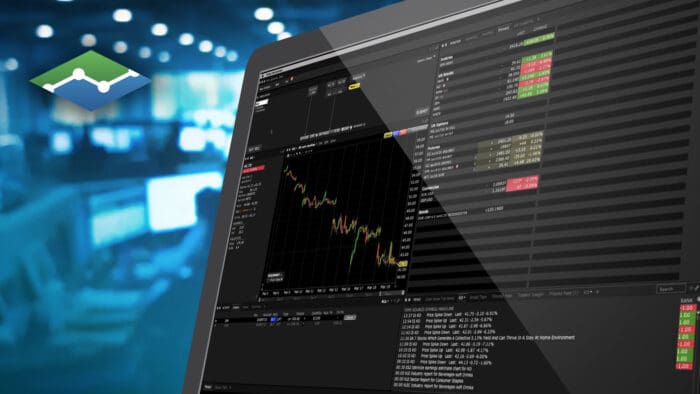Dmitry Pargamanik and Will McBride, the cofounders of Market Chameleon, join IBKR’s Jeff Praissman to discuss the importance and challenges of charting historic option prices and how an investor can make the best use of the results.
Corresponding webinar: https://ibkrcampus.com/webinars/historical-option-price-charts/
Summary – IBKR Podcasts Ep. 166
The following is a summary of a live audio recording and may contain errors in spelling or grammar. Although IBKR has edited for clarity no material changes have been made.
Jeff Praissman
Hi, everyone. My name is Jeff Praissman with Interactive Brokers, and it’s great to have the cofounders of Market Chameleon, Will McBride and Dmitry Pargamanik back in the IBKR studio.
Will and Dmitry, we just wrapped up a great webinar on historical option price charts, and I’m really excited to have you guys continue this discussion on our monthly podcast.
How are you guys doing?
Dmitry Pargamanik
Good. Thanks for having us, Jeff.
Will Mcbride
Great, Jeff. Thanks for having us.
Jeff Praissman
Oh, my pleasure. Let’s just kind of start at the beginning. How does a historical option chart differ from historical stock chart?
I’m guessing our listeners are pretty familiar with what a circle chart looks like, but maybe more familiar with seeing stock charts on any sort of financial services graph, but how does an option chart differ?
Dmitry Pargamanik
Yeah. When we look at a traditional stock chart, what we’re seeing are actual trades. And stocks have a lot of trades and that’s where you will see a plot throughout the day, a historical chart of actual trade prices. The situation with options is different because many options have zero trades
Some have very little trades, maybe a trade in the morning and in the afternoon. However, the option itself, it’s a derivative. The value will still change. The value will change because the price of the stock could change. Implied volatility could change and you won’t get that just by plotting a trade or two.
So what do you do? What do you plot is the question. In the options industry, the standard is referencing the options marked market because the options always have a bid and an offer created by the dealers and market makers. And if we reference the midpoint, we could consider that the market fair value, the price right in between the bid and the offer.
And to plot it, we would basically have to capture that midpoint as time goes on. Take snapshots of that midpoint correlated then with other things like the stock price time, and then we could plot the midpoint price of that option.
Jeff Praissman
Options are derivatives, obviously. And you could have an option that doesn’t trade at all, like you said, throughout the day, throughout the week, throughout the month And, looking at stock price, are there other items you might track as well, such as implied volatility? What else are you looking at when you’re charting an option?
Dmitry Pargamanik
Right. When we talk about options, there are a lot of different factors that can impact the option price. Of course, one of them could be the stock price. The price of the option has a sensitivity to the movement of the stock. We’ll call it the Delta. And the Delta can change over time or as the stock moves, it’s helpful to plot the stock price simultaneously to see how the option price and the stock price behave relative to each other.
However, we also have another factor that impacts the price of the option and that’s its implied volatility. If the implied volatility of the option increases, that will increase the value of the option.
If it decreases, it will decrease the value of the option. So how can we tell what are the factors impacting that option price? Well, now we’ll also need to plot implied volatility alongside the option price and the stock price.
So really you’re looking at three charts simultaneously to get a better sense of what’s impacting the option price as it’s moving over time.
The other thing is, of course, time decay, right? Time decay is as time goes on, the option price starts to decay because at expiration, the option price will reach parity. It’ll either be worthless if it’s out of the money, or if it’s in the money, it’ll be worth the difference between the stock price and the strike price, which is parity.
But there is time premium in that option up until expiration. So that you could really just kind of see over time as you get closer to expiration, how the option decays.
So the time chart will show you the decay, but plotting the implied volatility and the stock at the same time relative to each other really gives you a much more comprehensive picture of what’s going on.
Jeff Praissman
Now, we’ve covered a lot of ground with our podcasts and webinars over the years. And we’ve talked about, single options. In fact, we just talked about combinations a little while ago.
So my question to you is, are these charts only for single-leg options or can you use them for combinations as well?
Dmitry Pargamanik
So that’s a good question. Let’s say we wanted to track a call spread, which involves two legs. You’re buying one call, selling another call, or even a butterfly or you could have four legs and further.
So how do you plot that? Of course, you could try to apply each of the legs relative and try to figure out the difference, but that would be very painful to do.
So just like we would do with a single option we could take that spread, let’s say call spread and the NBBO of each option, which you need to capture simultaneously. What at each point were these options, bids and offers? And calculate the bid of the spread and the offer of the spread.
Let’s say it’s a call spread. What was the MBBO bid of the call spread and what was the MBBO offer? And reference the midpoint of that spread.
And of course that will give you a good picture of how this spread and how those options work relative to each other because these options have different sensitivities. One option might have a higher Delta and a different option has a lower Delta.
And if you’re buying one, selling one, some of the risks are off setting, you have different Vega and Theta. And this gives you a very good idea of how this spread behaves as time moves on, as the stock price changes and as implied volatilities are changing.
Jeff Praissman
Obviously research and data is key to investing. What our listeners really want to know is what uses are kind of typical for historical options, right? Where’s the value? Obviously there’s a lot of information in there, but what, maybe some scenarios , could be valuable for an investor or trader?
Dmitry Pargamanik
So when we look at a price chart, we’re looking back, right? It’s a look back at history. And what we want to do is try to learn and understand how the different market dynamics are impacting the option or particular strategy. For example, you could go look at a certain event like earnings.
How did this strategy or option behave the entire day from the morning up to the end of the day before earnings? How did the option behave the next day from the close to the open? How did the option behave after the open up to the close of the day?
And you could do that for many different types of scenarios. You could look at how an option behaved maybe on a day where the stock didn’t move that much. You could see the implied volatility or the decay kick in from the morning to the end of the day.
Or you could study other events that are happening all the time. Like a Fed speaker or economic release occurs or you could just correlate it with other events throughout the day.
And that’s one way to kind of understand how certain options behave to different influences in the stock market.
Jeff Praissman
Options have so many strikes, right? I mean, even the ones that are lightly traded, even just an option with four expirations, you’re talking multiple strikes.
How does the investor decide what strikes to chart or what to look at? Or is it really just kind of vary on what they’re looking to do? And then they kind of extrapolate what they need to look at?
Dmitry Pargamanik
So, of course you could try to chart any option or combination of options based on maybe certain things that you’re looking at. And typically, if you want to learn from a chart, you want to look at certain options that might already be more meaningful and have trading. So if you’re looking at how an option behaves maybe based on trading activity, you’d want to find something with a lot of trading, or a lot of open interest. Or where the markets are relatively narrow and competitive because you could look at a chart of a very wide in-the-money call that has no trades, but you might not get anything out of that.
So if you’re looking at particular strikes and trying to chart it out and see how it behaves, you may want to look at something that’s more liquid, maybe has open interest and has volume in that contract.
Jeff Praissman
In the beginning of this, you sort of touched a little bit on this, but I kind of want to deep dive a little bit deeper into it.
How does an investor compensate for Gamma and Delta changes in the strike throughout the chart? Obviously as the strike becomes more in-the-money, it’s going to be more sensitive to the stock price movement.
So you could see sort of an uneven move for the pricing of that option depending where the underlying is.
Dmitry Pargamanik
Yeah, exactly. For example, if we look at the price of a call, right? You may see the stock price moving higher, but the option price may sit at the same price or even move lower. So what’s causing that?
Obviously it’s not reacting to the Delta because the price is moving higher, but you could maybe witness that the implied volatility at the same time is moving lower, which would explain away some of that behavior.
Also, you have time decay. So of course there are many factors that are playing on the option price simultaneously.
It’s hard to, from a chart, really understand exactly how much of it is time decay, how much of it is implied volatility, how much of it is Delta. Looking at the chart, it won’t give you the exact breakdown, but you should be able to see on a relative basis if there’s something that is moving violently or if there’s spikes in implied volatility or a big spike in the price or the stock, the chart will point something out that is an extreme move.
Jeff Praissman
And what are some of the other challenges to using historical option charts?
Dmitry Pargamanik
So when we look at a stock chart, a stock itself doesn’t have an expiration. You could go back months and years going all the way back to its inception. Its IPO. One of the problems is that an option has an expiration and some options may have existed for a month, some a week, some may have only listed in a day.
Issue is then if you’re plotting that particular option and it was only listed for a week, you’re only going to get one week of data for that option, right? That’s it.
So because it has an expiration, you’re limited to the timeframe from the time that this option was listed to the end, right?
Then that option goes away. Maybe there’s a new option then listed, but then you’d have to start, from that new option because you’re plotting actual snapshots, actual observations. So that’s one of the difficulties with options. Another is if we’re plotting a midpoint, right?
So if we take the bid and the ask and we’re plotting the midpoint, well an option price could go wide. You could have an option that was a $1.00 to a $1.20. So the point’s a $1.10, but what if it goes from $1.00 to $5.00 all of a sudden? Is the midpoint that meaningful?
So the wider the option or the more that the bid and ask fluctuates, the midpoint itself becomes an unreliable mark.It becomes an unreliable reference to its true fair value because the wider it is, the option could be anywhere in between there.
Or if you have a $1.00 to $5.00, the midpoint itself may not actually be the fair value. It could be closer to the bid, closer to the offer. So that’s another thing when we reference the MBBO markets
And to offset some of that, what we find helpful is that we plot the bid and the offer at the same time. So this way you could not only track the midpoint, but the bid and the offer prices at the same time. And you’ll be able to see if those are really wide around the midpoint or are they narrow and how they fluctuate over time.
Jeff Praissman
Yeah, I was going to say, well, conversely too, if something’s kind of.. a bid ask is wider and say, there’s an order on the book that’s making it tighter, that midpoint could be skewed as well. So if it’s a $1.00 to a $1.50 and that midpoint’s a $1.25, but all of a sudden you have a $1.30 offer, now the midpoint’s $1.15 or so. Any kind of order on the book could skew that midpoint as well. Is that stuff marked?
How is the user supposed to know whether or not it’s an artificial ask or bid or a real one?
Dmitry Pargamanik
That’s another very good point. Let’s say you’re looking at a chart of an option over time and you’re plotting the bid and the offer at the same time. You might see something unusual where, let’s say it’s a call and the price is slowly ticking up, but you’re seeing that the bid is moving higher, ticking up, but the offer is staying the same.
So all of a sudden the market is becoming tighter, but it’s happening with a bias from the buy side, right? Because you would expect the bid and the offer to move together with the stock. Well, that could be an indication that there is a limit order on the book that’s sitting there and as the market is moving closer to it, you’re seeing the bids increasing. But the offer staying the same because it’s on a limit order book. It’s not a streaming quote. It’s not a dealer quote.
And that chart could help you detect that by watching how the bids and offers are behaving as the stock’s moving and how the spread between the bid and offer is behaving as well.
It could also indicate a potential pump. People can put an implied volatility pump into an option and the way that would work is besides having a limit order on the book that doesn’t move, it just waits for the market to get there.
You could put a pegged order in, which is an implied volatility where you want to better the market and you say, well, I want to buy or sell this implied volatility, but the market will move.
So your order will be pegged to the stock price. The idea there is if the stock is moving up, well, you’re going to move up with the stock in this case of a call because you’re trying to buy a certain implied volatility. So you’re not just sitting there. You might still be able to get a fill at that implied volatility.
And if the stock’s moving down, well, you don’t want to just sit there and buy the option because your intent is not to buy the option, but an implied volatility. So you don’t want to get run over. So your option will move down along with the stock price. But the idea there is that the implied volatility pump will squeeze the market on one side.
So that’s another thing. You might be able to actually put an indicator there if we detect that implied volatility pump. But that’s another thing you want to look for.
Jeff Praissman
And I would say lastly too, and we just talked about orders and implied volatility, but what about actual trades? How do they impact the chart?
Dmitry Pargamanik
That’s another good point. Well, we have the midpoint, right? And we have the bid and the offer. What about the trades?
Jeff Praissman
Right. The actual value, right?
Dmitry Pargamanik
Those are valuable too, because ultimately that could really be the determining factor what moves the implied volatility. So what do you want to overlay on that chart? If there are trades, right?
If you observe trades at any particular time of day, you want to be able to plot it. And not only the trade price. You probably want to plot the volume because that will make a difference as well. And you want to plot the implied volatility that it traded at. And then you want to see, did that create a shift anywhere in that chart?
Did the implied volatilities move up after that? Did it move down? Did it create a new fair value in the implied volatility? Did it create more trading? So that’s another factor that you would want to. Also view in your chart. The actual trading activity. So that’s a very good point.And then from that point, you could see how the price and implied volatility drifted post-trade.
Jeff Praissman
Any final thoughts for our listeners?
Dmitry Pargamanik
When you’re looking at learning about option trades and strategies, looking at price charts could be very helpful because you want to learn the dynamics. Especially if you have certain assumptions about how options behave in certain scenarios. You want to go back and validate that.
Another thing that historical charts can help with is validating and confirming trade pieces, right? If you have a thesis of how an option or strategy would behave given a certain scenario, let’s say the Fed announcement.
How does it behave now or before to an hour after? Well going back and looking at these price charts could be very valuable because you want to be able to at least validate your initial thesis before you continue to strategize because sometimes you may be surprised or you may find other factors in there that you didn’t think about that go into it, where it behaved a little bit differently or maybe a lot differently than you thought of.
And that gets you thinking about, well, what else came into play that I didn’t think about that I need to know before I go and jump into utilizing a certain strategy?
Jeff Praissman
Will and Dmitry, thanks again. This has been great. For past webinars and podcasts featuring Market Chameleon, please go to ibkr.com, click on Education and choose IBKR Campus and look for Market Chameleon under Contributors. There’ll be a link to the corresponding webinar in the study notes for everyone listening to this podcast.
I definitely suggest to anyone interested in learning more, watch the recording of the webinar as well. And for more great material from Market Chameleon and IBKR, just go to our campus. You’ll see upcoming webinars and podcasts.
Guys, thanks again. I love having you in the studio.
Will Mcbride
Great job, Dmitry. Thanks Jeff.
Disclosure: Market Chameleon
The information provided on MarketChameleon is for educational and informational purposes only. It should not be considered as financial or investment advice. Trading and investing in financial markets involve risks, and individuals should carefully consider their own financial situation and consult with a professional advisor before making any investment decisions. MarketChameleon does not guarantee the accuracy, completeness, or reliability of the information provided, and users acknowledge that any reliance on such information is at their own risk. MarketChameleon is not responsible for any losses or damages resulting from the use of the platform or the information provided therein. The 7-day free trial is offered for evaluation purposes only, and users are under no obligation to continue using the service after the trial period.
Disclosure: Interactive Brokers
Information posted on IBKR Campus that is provided by third-parties does NOT constitute a recommendation that you should contract for the services of that third party. Third-party participants who contribute to IBKR Campus are independent of Interactive Brokers and Interactive Brokers does not make any representations or warranties concerning the services offered, their past or future performance, or the accuracy of the information provided by the third party. Past performance is no guarantee of future results.
This material is from Market Chameleon and is being posted with its permission. The views expressed in this material are solely those of the author and/or Market Chameleon and Interactive Brokers is not endorsing or recommending any investment or trading discussed in the material. This material is not and should not be construed as an offer to buy or sell any security. It should not be construed as research or investment advice or a recommendation to buy, sell or hold any security or commodity. This material does not and is not intended to take into account the particular financial conditions, investment objectives or requirements of individual customers. Before acting on this material, you should consider whether it is suitable for your particular circumstances and, as necessary, seek professional advice.
















Join The Conversation
If you have a general question, it may already be covered in our FAQs page. go to: IBKR Ireland FAQs or IBKR U.K. FAQs. If you have an account-specific question or concern, please reach out to Client Services: IBKR Ireland or IBKR U.K..
Visit IBKR U.K. Open an IBKR U.K. Account